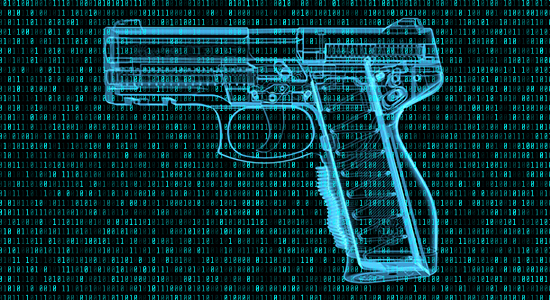
Aug. 15, 2018 – Last month, a federal district judge in Seattle issued a temporary restraining order prohibiting the internet publication of design files for the production of three-dimensional (3D) printed firearms made of plastic and other materials.
The lawsuit, filed by eight states and the District of Columbia, seeks to permanently stop the U.S. State Department from allowing Texas-based Defense Distributed, the brainchild of law school dropout Cody Wilson, from posting the Computer Aided Design (CAD) files on its website, with government permission, planned for Aug. 1, 2018.
Wilson, a self-described “crypto-anarchist,” was planning to release CAD files that would provide instructions to anyone in the world with a 3D printer and the right tools to make plastic, untraceable pistols and semi-automatic weapons, including an AR-15, and a “computer-controlled milling machine” to carve needed gun parts from aluminum.
The CAD files contain proven designs. Wilson successfully fired his first creation, a plastic .380-caliber pistol, on a Texas gun range in 2013. Then, according to Andy Greenberg at Wired, “he drove back to Austin and uploaded the blueprints for the pistol to his website, which was downloaded 100,000 times” before the feds shut it down.
“Wilson made the decision to go all in on the project, dropping out of law school at the University of Texas, as if to confirm his belief that technology supersedes law,” wrote Greenberg, noting that Wilson then took his fight to court, suing the government.
What is 3D Printing?
The concept of 3D printing surfaced decades ago, in the 1980s, but technological advances have allowed 3D printing to proliferate in the last decade.1 It can now be used to make countless three-dimensional objects, including prosthetic limbs, auto parts, home goods, hand tools, dental parts, chocolate, clothes, furniture, and guns.
 Joe Forward, Saint Louis Univ. School of Law 2010, is a legal writer for the State Bar of Wisconsin, Madison. He can be reached by email or by phone at (608) 250-6161.
Joe Forward, Saint Louis Univ. School of Law 2010, is a legal writer for the State Bar of Wisconsin, Madison. He can be reached by email or by phone at (608) 250-6161.
“Most 3D printers don't go beyond the size of household appliances such as refrigerators, but 3D printing could even scale up in size to build objects as big as a house,” wrote Jeremy Hsu at LiveScience back in 2013.
Three-dimensional printing involves the process of using a digital file to make solid, 3D objects. More specifically, additives are used to “print” a design-modeled object.
Through CAD or other design programs, a model of an object is created and fed to a 3D printer, which “prints” the object as designed using plastic or other materials. Seen as transformative for manufacturing, 3D printing will inevitably cross legal boundaries.
“It has the potential to change industry, end world hunger, and provide a new platform for creativity,” wrote Chicago intellectual property attorney Anne Lewis, four years ago, as a law student at Tulane University. “On the other hand, it could be seen as a Pandora's box, unleashing unregulated deadly weapons.”2
Wilson and Defense Distributed have forced the issue with 3D printed guns, and his fight to let others download his tested 3D gun designs is just the first frontier.
Free Speech vs. Export Regulation
Wilson argued in part that data, posted on the internet, constitutes speech that is protected by the First Amendment, regardless of the subject matter of the data. That is, he argued that 3D gun designs are information, free speech – not actual guns.
The government fought back under the federal Arms Export Control Act (AECA), which places restrictions on the export and import of “defense articles,” identified on the U.S. Munitions List, including nonautomatic, semi-automatic, and fully automatic firearms.
The list also includes “technical data” that directly relates to restricted defense articles. Under AECA, “[t]he President is authorized to designate those items which shall be considered as ‘defense articles’” and to promulgate rules for their import and export.3
The U.S. State Department was successful in prohibiting Wilson from posting his 3D gun files. In 2016, a three-judge panel for the U.S. Court of Appeals for the Fifth Circuit rejected (2-1) Wilson’s motion for a preliminary injunction, which would have let him post the gun files without a prepublication approval requirement for technical data.
The High Court declined review and the case may have continued on the merits, but the government switched gears last month, entering a settlement agreement that allowed unlimited distribution of Wilson’s gun files, with reimbursement for his $40,000 legal bill.
Wilson and Defense Distributed were set to post the downloadable, 3D gun files on Aug. 1, 2018, but the federal district judge in Seattle halted that in the 11th hour, concluding the plaintiff-states showed a likelihood of irreparable injury.
“If an injunction is not issued and the status quo alters at midnight tonight, the proliferation of these firearms will have many of the negative impacts on a state level that the federal government once feared on the international stage,” the judge wrote.
The plaintiff-states – Washington, Connecticut, Maryland, New Jersey, New York, Oregon, Massachusetts, Pennsylvania, and the District of Columbia – had argued that a release of Wilson’s CAD files presented a serious threat to national security.
“Anyone with access to the CAD files and a commercially available 3D printer could readily manufacture, possess, or sell such a weapon – even those persons statutorily ineligible to possess firearms, including violent felons, the mentally ill and persons subject to protection and no-contact orders,” the states’ complaint argued.
Fight Not Over
Although the federal judge in Seattle said “the balance of hardships and the public interest tip sharply” in favor of the plaintiff-states, not all judges may agree with that.
Back when Wilson was in federal court in Texas, the Fifth Circuit Court of Appeals declined, by a 9-5 vote, to review the case en banc, which prompted a sharp dissent from one judge, joined by four others, who thought the majority was mistaken.
Recall, Wilson sought a preliminary injunction that would have enjoined the government from halting his plans to publish the 3D gun data online while the case was pending.
“The panel opinion’s public interest analysis is also flawed because it relies on a mere assertion of a national security interest,” one dissenting judge wrote. “Certainly there is a strong public interest in national security. But there is a paramount public interest in the exercise of constitutional rights, particularly those granted by the First Amendment.”
After the most recent ruling in Seattle, U.S. Senator Bill Nelson (D-Fla.) reportedly attempted to pass a bill that would outlaw intentional publication of instruction files to manufacture 3D firearms, but U.S. Senator Mike Lee (R-Utah) blocked the bill.
Then on Aug. 1, White House Press Secretary Sarah Huckabee Sanders said the U.S. Department of Justice entered a settlement with Wilson “without the President’s approval” and suggested President Trump was “glad” posting was delayed.
The U.S. District Court for the Western District of Washington in Seattle held a hearing on Aug. 10 to determine whether the temporary restraining order blocking publication of the CAD files by Defense Distributed should be converted to a preliminary injunction.
As of press time, the district court had not reached a decision.
Endnotes
1 Pagan Kennedy, Who Made That 3D Printer? The New York Times (Nov. 22, 2013).
2 Anne Lewis, The Legality of 3D Printing: How Technology is Moving Faster Than the Law, 17 Tul. J. Tech. & Intel. Prop. 303 (Fall 2014).
3 22 U.S.C. § 2778(a)(1).
